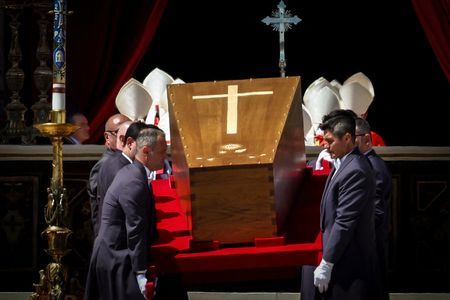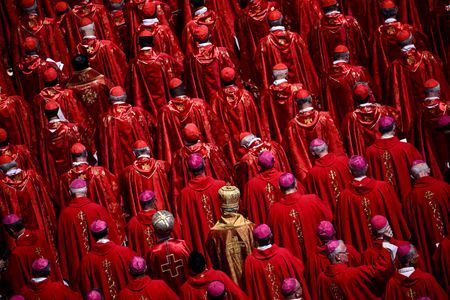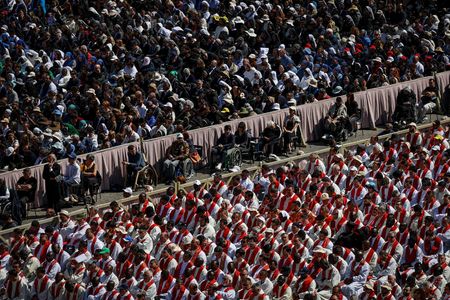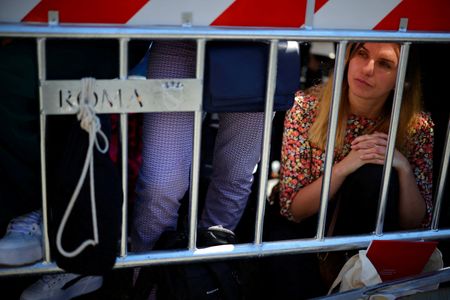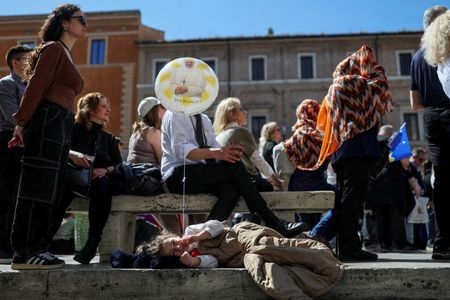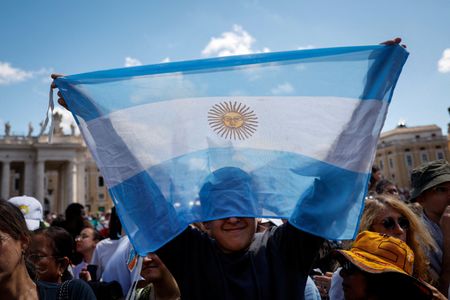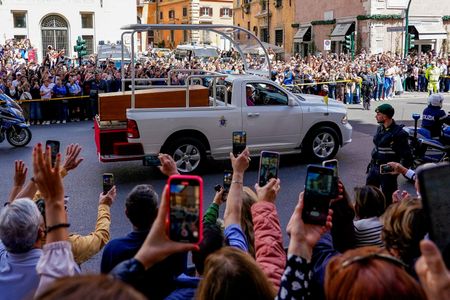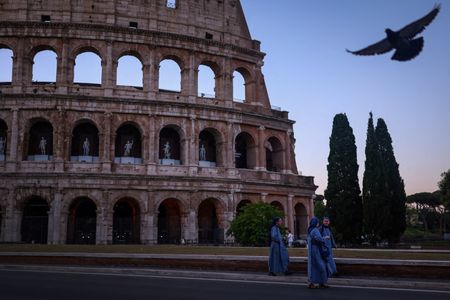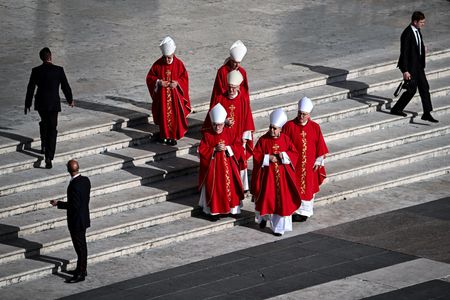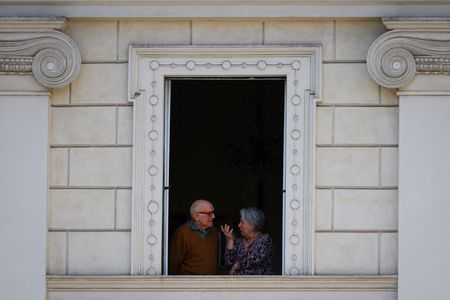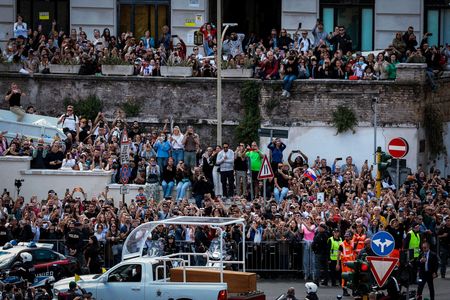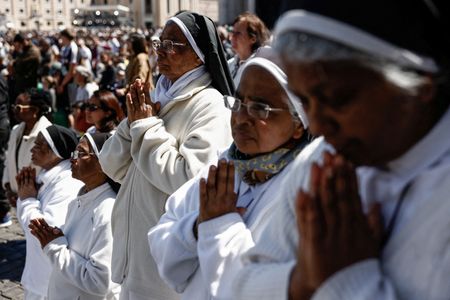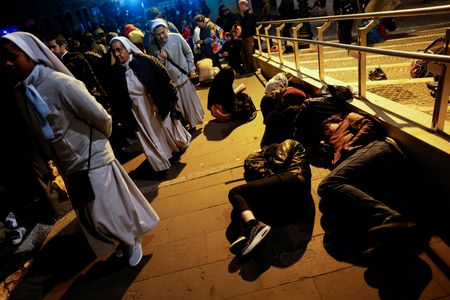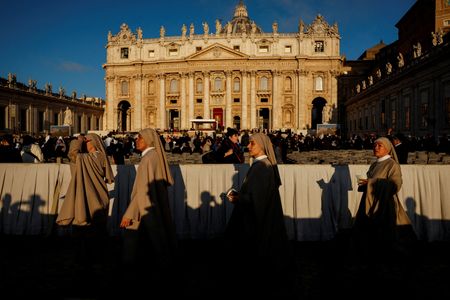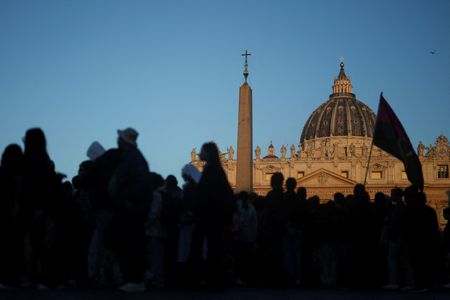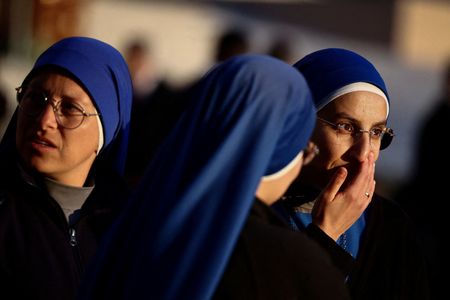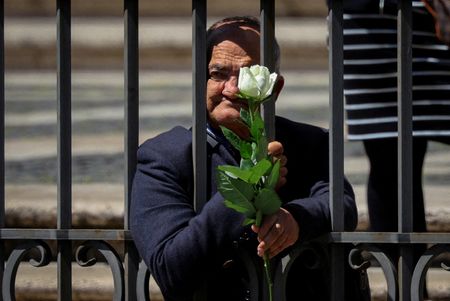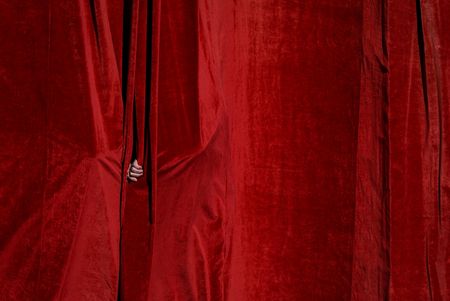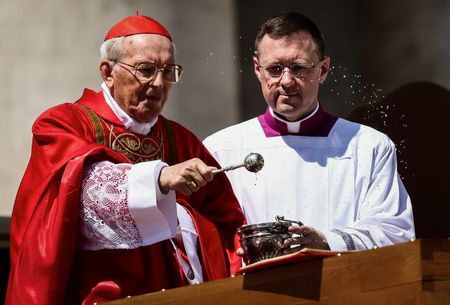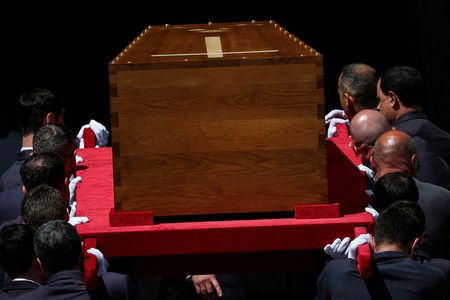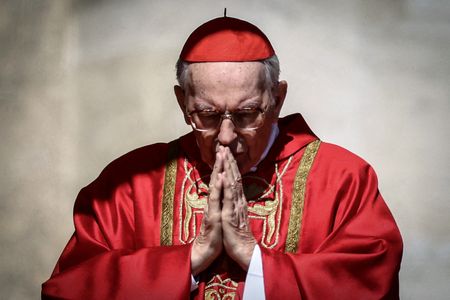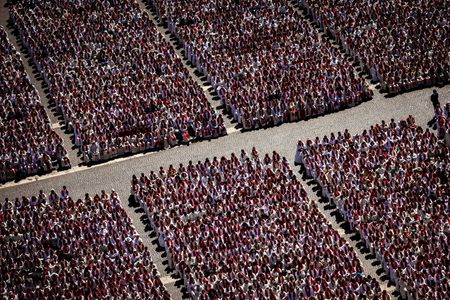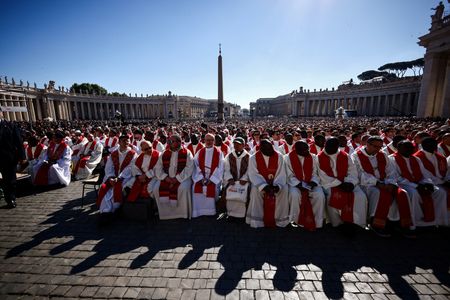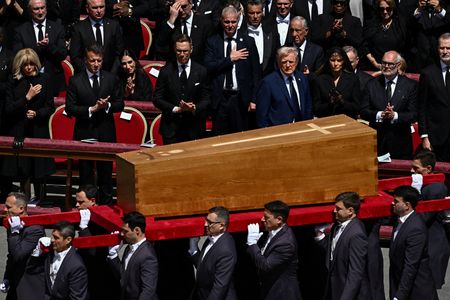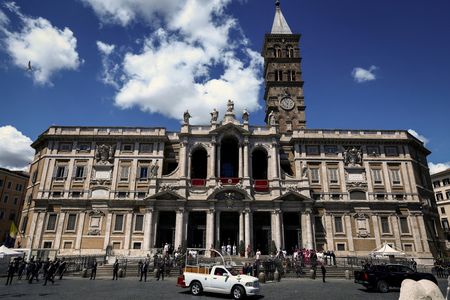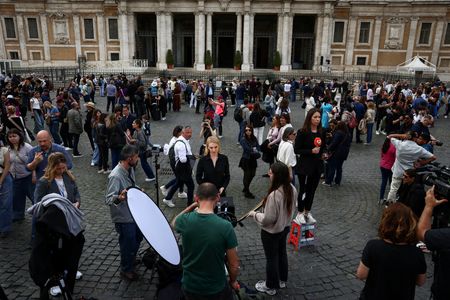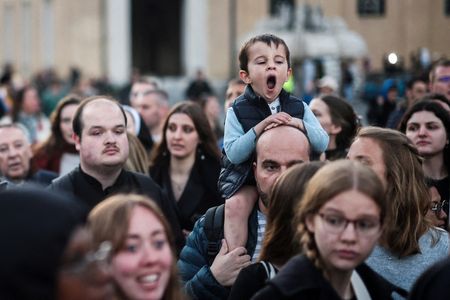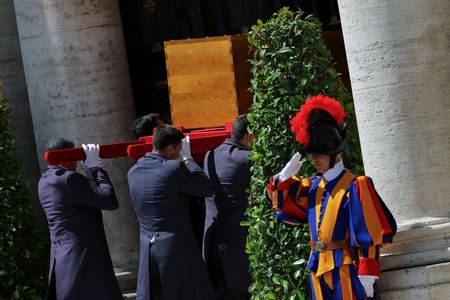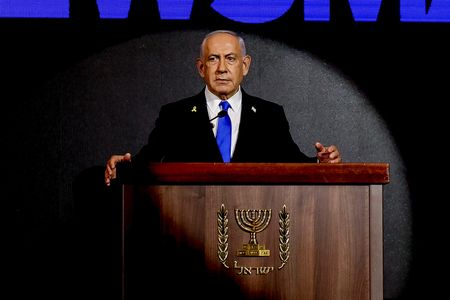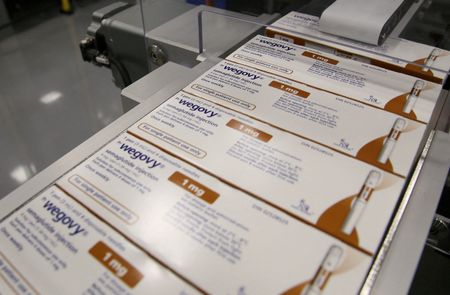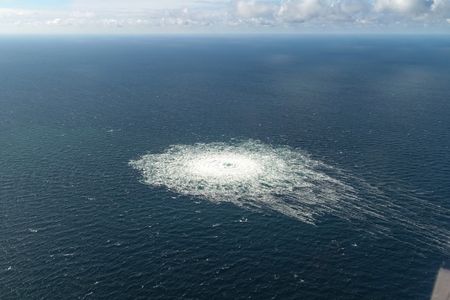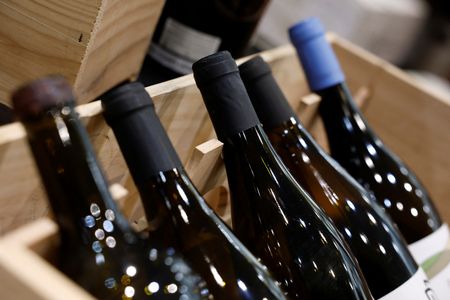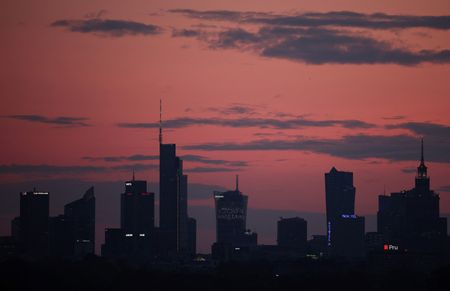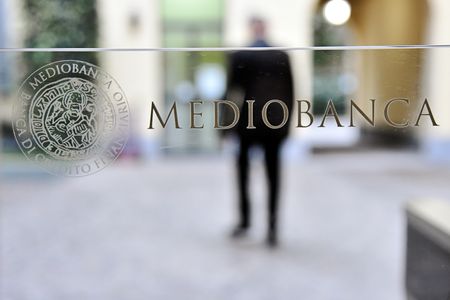By Keith Weir and Alexandra Hudson
VATICAN CITY (Reuters) – Pope Francis’ funeral brought world leaders, monarchs, and hundreds of thousands of people to Rome on Saturday to bid him farewell in a ceremony of breathtaking spectacle that offered age-old Catholic funeral rites and touching moments of personal grief.
Sixteen Reuters photographers, some inside St. Peter’s Basilica, others perched on podiums or deep within the crowd, shot the key moments and conveyed the sheer scale, capturing the solemnity as the pallbearers raised the pope’s simple coffin and individuals clasped their hands in silent prayer.
Rows of cardinals in their flowing bright red robes prayed and bowed their heads, nuns clutched rosaries and images of the pope, and pilgrims young and old battled with their exhaustion after waiting for hours.
“Seeing the square from above, the casket, the silence, and the thousands of people there to pay tribute to one man — it’s something very hard to put into words,” said Reuters Rome-based photographer Yara Nardi.
The death of 88-year-old Francis early on Easter Monday (April 21) came as a jolt after he had appeared in public on Easter Sunday, and set in motion coverage plans that had been long in the works but needed to be acted on immediately.
Photographers flew in from as far away as Brazil and Doha to join Reuters’ visuals team in Rome. Some had covered the funeral of Pope John Paul II in 2005, which meant they could anticipate some of the most powerful images. Others were working on such a large-scale event for the first time.
The run-up to the funeral was intense with photographers working long hours capturing mourning as the pope lay in state, and the late-night arrival of leaders including U.S. President Donald Trump.
On the day, the team set their alarms for as early as 3 a.m. (0100 GMT), seven hours before the start of the funeral, to ensure that they could get through crowds, security checks and then the inevitable jockeying with photographers from other media outlets to ensure a prime spot.
Blue skies and a fluttering breeze helped to create vivid images, but the high spring temperatures were a challenge for sleep-deprived photographers.
The pope’s decision to break with tradition and be buried in the St. Mary Major Basilica saw his coffin driven through the streets and past crowds at Rome’s ancient monuments, allowing a chance to capture compelling images from along the route.
“I think being around large groups of religious people, whatever your faith, is always touching. I was there the day Francis was elected and that is maybe one of the most incredible things I have ever done – so to go full circle was amazing,” said London-based photographer Dylan Martinez.
Below is a selection of some Reuters pictures taken during the events of the day along with comments from the photographers who took them.
Photographer Quotes
Yara Nardi, Reuters photographer based in Rome, Italy
“We were given about 40 seconds for the photo from the statue of Christ inside the Basilica. It was my first time up there, and I got goosebumps the moment I arrived. Seeing the square from above, the casket, the silence, and the thousands of people there to pay tribute to one man—it’s something very hard to put into words.”
Mohammad Salem, Gaza Senior Visuals Journalist based in Doha, Qatar
“I encountered this scene when everyone attending the Pope’s funeral was waiting outside the church. Sadness enveloped everyone, and it was a sorrowful moment. What caught my attention was this girl holding a picture of the pope.”
Kai Pfaffenbach, Reuters photographer based in Frankfurt, Germany
“The fluttering of the pages of the Book of Gospels on the pope’s coffin was very special as it also happened during the funeral of Pope John Paul II in 2005 which I covered. It happened at the end of the Mass, and I immediately had John Paul II’s funeral in mind, but newer camera technology made it easier to capture the moment this time.”
Claudia Greco, Reuters photographer based in Milan, Italy
“The day’s challenges were technical. I was assigned to a spot in front of the Basilica and we were escorted to the area 10/15 minutes before the arrival of the coffin, so I had to fight for a position, as front on to the door as possible, and quickly try to activate the setup for the Wi-Fi.”
Dylan Martinez, Senior Photographer, Special projects Europe and other regions, based in London, Britain
“I moved positions to find a spot to photograph the coffin passing Trump. I managed to squeeze into a very tight spot, precariously balanced on two chairs. In the end I was lucky with the angle and the way it lined up.
I think being around large groups of religious people, whatever your faith, is always touching. I was there the day Francis was elected and that is maybe one of the most incredible things I have ever done – so to go full circle was amazing.”
Alkis Konstantinidis, Greece Chief Visuals/Chief photographer Central and Eastern Europe based in Athens, Greece“These were the last moments before the pope’s coffin entered the Basilica. The pallbearers slightly raised the coffin so that the people could say farewell to Pope Francis. Suddenly from the utter silence, people started applauding and shouting goodbye to the pope. At that moment, I decided to shoot a wide frame to include as many elements as possible of a historic moment, the death of a pope, and the burial outside the Vatican.”
Vincenzo Livieri, freelance photographer based in Rome, Italy
“We had been told in a press release that the car would move at walking pace, so I had planned to take a clean background shot first and then follow to capture the crowd’s reactions. Instead, the car passed much faster than expected, and I could only get the first type of shot.
I gave my stool to an elderly woman next to me who was struggling with leg pain and exhaustion. She had come all the way from northern Italy to attend, despite her health issues.”
Remo Casilli, Reuters photographer based in Rome, Italy
“There was a contrast between the jovial atmosphere that the Jubilee events have brought to the Vatican and the grief over the Pope’s death.
The photo above was probably the first chance to take pictures of the hearse carrying the coffin of Pope Francis. Also I liked the composition of the picture, with people placed at different levels, almost all taking pictures.”
Kevin Coombs, Pictures Production Editor, based in London, Britain
“I was walking from St Peter’s Square to the side entrance of the Vatican to scout a shot of the popemobile when it came about. The nuns were just standing right there.
I love to look around the edges of an event, to go down a street that perhaps no one else would bother with. There is usually something interesting to be found, and the pictures to be taken can really complement the main news pictures shot from the photographer on the podium.”
Guglielmo Mangiapane, Reuters photographer based in Rome, Italy
“I was waiting for the Mass to start and looking for feature images when I saw this guy sleeping in the middle of the square and I could really relate to him. I thought he was in the same condition as I was. This is, however, one of those events you really feel lucky to witness.”
Mangiapane had had only one hour of sleep the night before the funeral.
Hannah McKay, Reuters photographer based in London, Britain
“I was working on the Via Della Conciliazione to look at the faces of the people watching and listening to the funeral service in front of the Vatican, and out of the corner of my eye I could see a balloon with an image of the Pope on it bobbing up and down. So I made my way through the crowd and there laying on the ground playing with the balloon was 4-year-old Elizabetta Campagna. I quickly took some photographs of her before she moved and then approached her mother to ask for her name and age. It was just a nice moment of a youngster, amongst a sea of faces.”
Susana Vera, Reuters photographer based in Madrid, Spain
“When the pope’s coffin was taken away, I saw someone holding an Argentine flag and I made my way to shoot as he was raising it in the air, waiting for the flag to partially cover his face and have the rest of his head and arms silhouetted. Bergoglio (Francis) was from Argentina, and he was the first Latin American pope, so it felt important to try to capture that in the coverage.”
Matteo Minella, freelance photographer based in Rome, Italy
“The most important thing I tried to do was never to interrupt a deeply intimate moment like prayer with my presence, so that the photos I took would truly represent that instant in the most authentic way.
Many of those young people had spent the night in the streets near St. Peter’s, and once they entered the square and secured a spot, they fell asleep — some woke up as soon as the funeral began, others only after it ended.”
Carlos Barria, Reuters photographer based in San Francisco, California, USA
“The challenges are numerous, ranging from the long hours of work, to navigating the crowd of thousands and attempting to send pictures with slow internet due to the overcrowding. But we never lost sight of the story, which is about the people who came to the Vatican to attend this event.
Sometimes, during long hours of waiting, I take the time to look around and find those quiet moments that reveal the context of the story. Like the picture of Antonino Siracusa, part of a group of homeless and poor chosen to bid a final farewell to Pope Francis.”
Matteo Ciambelli, freelance photographer based in Naples, Italy
“The procession was only in front of me for a few seconds. I had to track the vehicle carrying the coffin with my camera while adjusting for the changing light as clouds moved across the sun. The raised arms of mourners and the phones held high to record the moment added emotional depth to the scene. Once the coffin came into view, it was simply a matter of following the car and pressing the shutter.”
Amanda Perobelli, Reuters photographer based in Sao Paolo, Brazil
“I have never covered an event this big and this historical, and this is also my first time in Italy. Rome kind of breathes religion and Catholicism. I thought this image was interesting because the Colosseum has so much history itself, and this is part of that history now.”
(Writing by Keith Weir; Editing by Alexandra Hudson)

